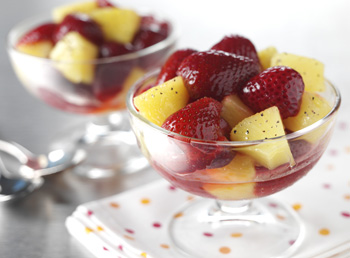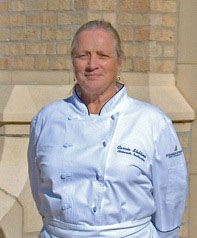Sausage Making: Easy as Biting into a Brat
 The U.S. renaissance in charcuterie coupled with diners’ love of sausage makes housemade sausages a customer-satisfying, brand-building notion.
The U.S. renaissance in charcuterie coupled with diners’ love of sausage makes housemade sausages a customer-satisfying, brand-building notion.
By Christopher Koetke, CEC, CCE, HAAC
More and more chefs at U.S. restaurants, hotels and clubs are wowing diners with interesting sausage inspirations that perfectly balance savory, sweet, spicy and smoky. Americans’ ever-increasing desire for good sausage is why culinary students enrolled at the Kendall College School of Culinary Arts in Chicago learn sausage-making during their first year of study.
Indeed, today’s sausages—as links, patties and crumbles—can showcase any ground meat combined with sufficient animal fat and any combination of a vast array of seasonings and other flavoring ingredients.
Thanks largely to chefs’ sausage inventiveness, the homemade-sausage trend is also propelled in part by growing consumer interest in enjoying fresh, locally grown and raised ingredients. European and other heritage sausages are enjoying a renaissance, too.

 Good news for graduates this year is that foodservice in healthcare and B&I is projected to expand, says Technomic.
Good news for graduates this year is that foodservice in healthcare and B&I is projected to expand, says Technomic. More popular than chocolate and potato chips, snacking occasions bearing fruit are growing.
More popular than chocolate and potato chips, snacking occasions bearing fruit are growing. Like the many herbs cultivated for healthy, flavorful dishes and cocktails at the new Seasons 52 in West Los Angeles, executive chef and partner Jessica Koine finds a place to grow.
Like the many herbs cultivated for healthy, flavorful dishes and cocktails at the new Seasons 52 in West Los Angeles, executive chef and partner Jessica Koine finds a place to grow. Assigning students to write a white paper can help them focus on an audience, develop an appropriate voice, learn to make a solid case with evidence and conduct careful research.
Assigning students to write a white paper can help them focus on an audience, develop an appropriate voice, learn to make a solid case with evidence and conduct careful research. S
S Rotating groups through learning modules keeps students engaged while enhancing their skills development.
Rotating groups through learning modules keeps students engaged while enhancing their skills development. Coors Recycles® teams up with Recyclebank® to reward consumers for their environmental efforts.
Coors Recycles® teams up with Recyclebank® to reward consumers for their environmental efforts. Highly accomplished chef, restaurateur and author Waldy Malouf has a new mission. After a successful 13-year run as co-owner and chief operating officer of Beacon in New York City, Malouf became the senior director of special projects at The Culinary Institute of America (CIA) in Hyde Park, N.Y., on January 21, 2013.
Highly accomplished chef, restaurateur and author Waldy Malouf has a new mission. After a successful 13-year run as co-owner and chief operating officer of Beacon in New York City, Malouf became the senior director of special projects at The Culinary Institute of America (CIA) in Hyde Park, N.Y., on January 21, 2013. As the city’s financial district bustled through its morning rush hour outside of the historic Union League Club of Chicago, inside, 98 students of The French Pastry School of Kennedy-King College at City Colleges of Chicago took the first steps toward beginning their new vocation. Graduates of the full-time programs, L’Art de la Pâtisserie and L’Art du Gâteau, celebrated their commencement on the same day that the school received one of the highest honors that educators can be given by the French government: Ordre des Palmes Academiques (Order of Academic Palms), a recognition that was instituted by Napoleon to award “teaching and the development of knowledge.”
As the city’s financial district bustled through its morning rush hour outside of the historic Union League Club of Chicago, inside, 98 students of The French Pastry School of Kennedy-King College at City Colleges of Chicago took the first steps toward beginning their new vocation. Graduates of the full-time programs, L’Art de la Pâtisserie and L’Art du Gâteau, celebrated their commencement on the same day that the school received one of the highest honors that educators can be given by the French government: Ordre des Palmes Academiques (Order of Academic Palms), a recognition that was instituted by Napoleon to award “teaching and the development of knowledge.”